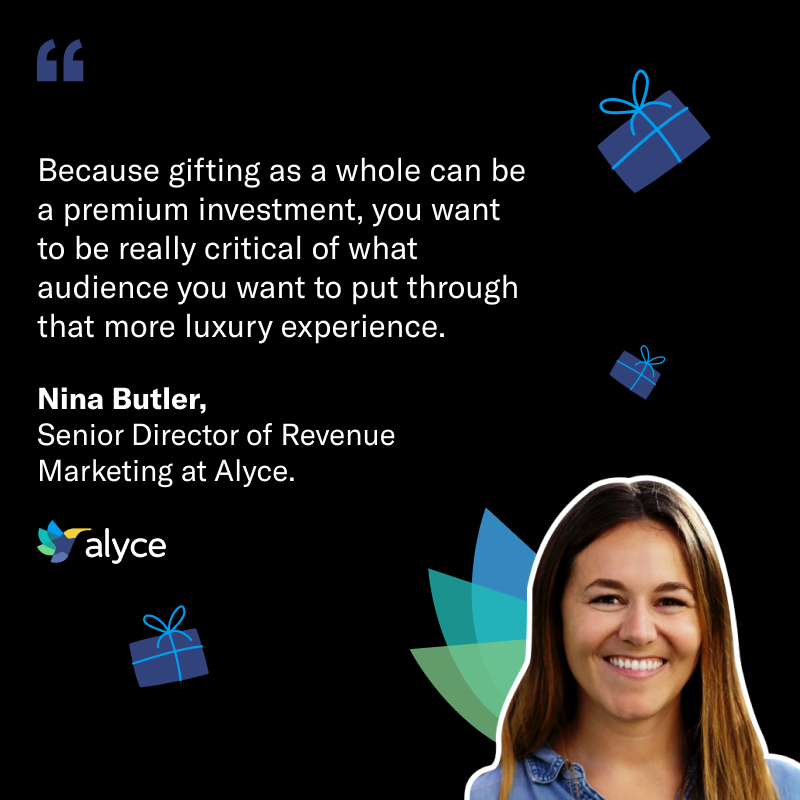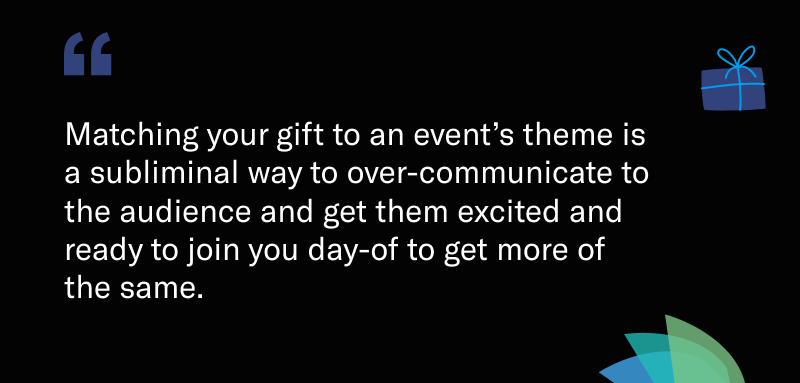Supercharge Your Virtual Events With Smart Gifting

Maximize Your Marketing ROI
Join 10,000 other marketers already getting the best tips on running engaging events that boost pipeline and create raving fans.
Let’s talk about gifting. More than just well-timed swag to woo prospects, gifting is quickly growing into one of the most impactful revenue-generating channels for B2B companies.
So, how does gifting work? And how can gifting tie into existing marketing initiatives, like events? You’ve got questions—and so did we! That’s why we partnered with Alyce for a webinar all about “smart” gifting!
Alyce is the first and only AI-Powered Smart Gifting Platform for business swag services that uses its best-in-class experience, intelligence, and execution to drive greater impact. So, they know a thing or two about gifting as a pipeline accelerator.
Nina Butler, Senior Director of Revenue Marketing, joined us for a lively session where she taught us:
- The definition of “smart” gifting 🎁
- Best practices for gifting before, during, and after events ✅
- Three unique gifting ideas 💡
- #GiftingFails - two mistakes to avoid 🛑
- … much more! 👏
Whether you’re new to gifting or you’re looking for smart ways to level up your approach, this webinar is for you!
Check out our recap below 👇 and be sure to check out the full recording for even more hot gifting tips!

What is “smart gifting”?
When you think about how we gift in our everyday lives, there’s such an emotive connection to that. So, smart gifting is really about capturing that sentiment but translating it into a business relationship context.
And what makes it so “smart” is that it’s not just that experience, but also the intersection between experience, intelligence, and execution. How can you use data and artificial intelligence to make your gift more intentionally? How can you find the best places in the customer journey to introduce a gifting moment? And, how can you combine those things with a memorable execution?
We want to make sure both the sender of that gift and—most importantly—the recipient of that gift, have a beautifully executed experience that they can go rave to their friends about.
“Smart gifting is really the marriage of experience, intelligence, and execution.”
When it comes time to choose a gift, how much should you spend?
This is a really common question!
Before we get to the tactical—how much is too much or too little to spend on a gift —we need to back up and think about all of the opportunities where you might want to introduce a gift. Are you trying to drive a certain outcome? Incentivize an action in the relationship?
As a result, when you think about all of those different moments in the customer journey, there are plenty of interactions at the top of the funnel. For example—incentivizing engagement around a piece of content, encouraging people to register for your events, having people listen to your podcast, or just getting folks to your website.
When you think about it in that application—it’s a little bit more of a higher-volume, lower-value play because you actually haven’t earned the right to put that audience through a hyper-personalized, whiteglove experience yet. You haven’t earned that opportunity to get that comfortable and familiar with them.
“It’s more of a high-volume, low-value play in the beginning because you actually haven’t earned the right to put that audience through a hyper-personalized, whiteglove experience yet.”
So ideally, as you’re taking that customer or prospect on that journey, you get more familiar with their brand, your brand sentiment and loyalty starts to increase, they start to get more focused on who you are as a product (not just a logo). Then, suddenly, you’re thinking about what opportunities you have to introduce gifting in a mid-funnel or down-funnel accelerator play.
That’s where you might want to be thinking about lower-volume, higher-value gifts. That’s where the sales prospecting use case comes in. You’ve identified who your ideal customers are, you know who the right personas or target contacts are at those accounts, you’ve warmed them up in the earlier stages of the marketing funnel, and now you want to introduce gifting with a bit more premium of an offer. That’s how I like to think about it.
And, of course, once you’ve earned that piece of business, there’s a whole other side of the funnel where you can think about—how can I use gifting to retain customers? To surprise and delight customers? To deepen relationships? To say sorry (we all mess up!). So, there’s a lot of interesting customer moments where you can think about introducing a gift.
Ultimately, your approach to gifting really depends on where you’re looking to drive better outcomes in the funnel.
In terms of price points, generally speaking, when you’re gifting more top-of-funnel (a marketing-led use case), try to keep those gifts in the $5 to $30 range.
Farther down the funnel (a sale-led use case), $45 - $60 is a good price range. Generally speaking, anything more than that can actually be off-putting.
If you’re prioritizing the recipient first, you are creating an equitable relationship (one that’s built around reciprocity), the messaging that you’re providing is value-oriented and relevant to them—if you’re putting in all that work, then you’ve earned the right to start a relationship.
“Your approach to gifting really depends on where you’re looking to drive better outcomes in the funnel.”
Is there ever too much gifting?
The more you introduce gifting into the customer or prospect experience, the higher likelihood you see of those gifts being accepted. Meaning, you’re starting to build up that brand recognition and you’re seeing those folks move through the funnel more quickly.
From our point of view, there’s no such thing as too much gifting—but you really do want to be smart about where you’re introducing gifting. You don’t want to gift just for the sake of gifting.
“From our point of view, there’s no such thing as too much gifting.”
What about post-event gifting? What tactics do you see that work really well?
Because gifting as a whole can be a premium investment, you want to be really critical of what audience you want to put through that more luxury experience. You have a whole host of individuals post-event, and you really want to be critical about how you segment them out.

First off, folks who attended and who didn’t attend—that’s an easy way to think about segmenting your audience. Within attendees, you have prospects and customers. Same with those who didn’t attend. And within your customer base, you probably have varying levels of familiarity or emphasis that you’re looking to put on that account.
Once you widdle these segments down, we really encourage you to reserve that sales-led use case for the tip-top, cream-of-the-crop audience that you’re looking to accelerate with a personalized, 1:1 experience.
When you think about the tier that’s slightly above that—you still want to leave a lasting impression, you still want to create momentum in this relationship, but it doesn’t happen to be a target account—you might go with a more marketing-led follow up. Maybe you don’t have a hard call-to-action, like a meeting booked requirement, but maybe you have a softer ask, like a post-event survey or reading additional content about the event topic.
From there, you have your final tier—folks that should really be put in 1:many post-event experiences. This might be completely marketing-led through automation with a campaign or nurture.
This mirrors similarly for customers, but you’re in a much different relationship with those folks, so the approach might be a bit more nuanced.
What are some really unique executions of “Smart Gifting”?
Oh, this is a fun one!
The first one that comes to mind is when you want to incorporate “smart gifting” into your pre-event strategy. Think about if there’s some sort of thematic element to your event, like your event’s host city. Or if the event itself is focused around a particular content angle that has a strong theme. Matching your gift to that theme is a subliminal way to over-communicate to the audience and get them excited and ready to join you day-of to get more of the same.

For example, we were recently in Austin, Texas for a local event. We put together a gift marketplace that featured all sorts of locally-inspired gifts. We had music gifts, food gifts, and lots of Austin-themed giveaways. That way, the recipients, whether they were virtual or in-person, could take a little bit of Austin, Texas home with them. It was a huge hit! I’m actually still getting “thank you” notes from the event.
Second, you can also incentivize registration or show-rates, which, over the past 18 months, have been declining. It’s hard! How do we keep people excited and keep the stamina up? How do we make sure they actually show up to the event?
We did this for another recent event. We sent everyone who registered in time a lunch gift card.
Once you establish that reciprocity with your audience by sending them something small that they can enjoy during the event, it’s going to incentivize them to actually show up. Think about what you can pair like a meal or activity that aligns with the time of day of the event.
Finally, you can encourage certain session attendance with gifts. We did this last fall for our YOUniverse event. We incentivized folks to stay for the final keynote (a big ask for an online event!) by saying that everyone who was online during the session would get a special Alyce gift.
And, thanks to platforms like Goldcast, we’re able to understand the analytics and execute that play the moment the event ends. So, it’s really important to have not only the ideas but also the infrastructure to help you execute those ideas and deliver on your promises.
How do you measure success with the gifts you send?
In Alyce, you can measure the conversion rate of that gift through the gift’s lifecycle. You can see when that gift has been viewed, when it’s been accepted, and if the required action has been completed.
Now that you’re able to understand the benchmarks at each stage, you can start testing different gifts to optimize the experience.
And then through integrations with other tools, you can really figure out an ROI per gift.

There’s a misconception that you can find someone the perfect gift. I don’t know if the idea of a perfect gift exists because everybody is so individualized.
Platforms like Alyce give you the power of choice to let people pick the best gift for them. Ultimately, the pressure isn’t on the sender to nail the gift. Instead, it’s putting the power of choice back onto the recipient to walk away with something they love.
Is there a gifting strategy that you’d launch for awareness? If something’s not quite measurable but gives you a good feeling for the branding aspect?
There could be things that are more top of the funnel, less conversion-oriented where you want to position and present your brand in a memorable way. Gifting can definitely help you satisfy that goal.
There are parts of our own strategy, more on the content side, that take this approach.
We don’t gate 99.9% of our assets. So, it’s hard to track how gifting correlates to downloads of an ebook, for example.
Instead, we think about value-additive content that people are going to want to consume at their leisure, and then we’re able to understand who has taken that type of engagement and just send them a surprise and delight gift to thank them for taking that action.
“Gifting doesn’t always have to be the carrot on the stick.”
Gifting doesn’t always have to be the carrot on the stick. You can instead reframe where it’s introduced in that person’s experience and reframe it as a surprise and delight moment. No strings attached. No hard ask. Instead, it’s us thanking you for spending time at our event, consuming our content, joining our podcast, contributing to our blog, whatever it might be.
There’s also a lot to be said on the customer side of the house. Customer marketing is becoming the new demand generation. Marketers are responsible for more of the funnel than they ever have been before. Retaining and growing books of business is the new direction strategically.
When you think about gifting in the customer base, think about all of these different milestones in the relationship you have with them—product usage, they just got promoted, their company just got funding, a new hire, etc. There are all of these different ways you can drive that surprise and delight. There’s no ask of the customer, but when it comes to renewal, they’re going to remember all those individual moments and how you’ve made them feel in that relationship.
“Marketers are responsible for more of the funnel than they ever have been before.”
What are some cautionary tales on #GiftingFailures?
Oh boy! Well, there are definitely a few we see more often.
First, when the value of the gift is not near where you’re at with the person.
For example, sending things that are really extravagant and elaborate to a contact that you have no relationship with and their company isn’t quite sure what your product or service does or what it’s value is.
Conversely, if you’re coming up on a three-year renewal with one of your most tenured customers and you send them a $5 coffee gift card. They’re probably thinking—what?!
“Make sure that you’re mirroring the perceived value of that gesture with the actual point in the customer’s journey that they’re at with you.”
The second thing that comes to mind —and this might be a hot take—but I often see marketers introducing a swag experience at the incorrect moment in a customer’s journey.
If you haven’t built up brand recognition and then affinity and then loyalty, you could actually be introducing swag at a point in time where the person’s like—I don’t want to rep your stuff.
Instead, think about gifting people with swag if they’ve given you a case study, provided a referral, or just did a renewal. Those are your champions and advocates, and those are going to be the folks that are way more apt to rep your brand and rep it with pride.
So, make sure that if you're thinking about introducing swag at any point in the prospect or customer journey that you're really making sure that it’s the right time and that they have the right familiarity with your brand to do that.
The whole point of swag is to get brand impressions, so what’s the point if it’s sitting on a shelf?
“Spoiler alert for all of those trade show t-shirt leads: they don’t turn into revenue.”
Thanks, Nina, for joining our event and sharing your expertise. Gifting a space where we see a lot of momentum building, and we’re very excited to see where Alyce takes it next.

Transform Your Video Marketing with AI
Stay In Touch
Platform
Resources
© 2025 Copyright Goldcast, Inc. All rights reserved.





 Upcoming Events
Upcoming Events Event Series
Event Series On-Demand Events
On-Demand Events

